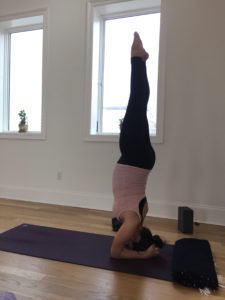by Nicole Horne
Roughly twelve weeks later and twelve pounds heavier: in a relatively short amount of time, life feels transformed, and the sphere of my life that is the practice has taken on a new breadth.
Like clockwork, the morning sickness faded near 12 weeks’ gestation. Soon I was back to my old routine (with a few minor adjustments): wake up, have a small bite, practice. Though my energy was slow to return, and the asanas resembled less and less their pre-pregnancy form, I felt true delight being able to return to my daily ritual.
I’ve heard many female practitioners say that pregnancy invited a softer approach to the physical practice, and this was no different for me. Even in my day-to-day, I felt myself become more mellow, and this mellowness translated to a more patient and accepting Ashtangi. Consistency became more important than completion; the idea of “finishing” the sequence mattered less than simply getting on the mat. This mental adjustment was important in terms of sustainability, as I was constantly re-learning my own body and mind: reading my fluctuating energy levels, understanding the increasing limits of my physical capabilities, and incorporating the perceived needs of this brand new being I’d be carrying around with me for the next six months.
Safely crossing the threshold into the second trimester was significant, as it is for most women eagerly awaiting motherhood. The added sense of security allowed the reality of the pregnancy to sink in, and I slowly began imagining my life with a child. I consciously tempered my excitement, though, until the 20-week scan, when I could be reassured (as best as possible) about the state of the baby’s health and development. After receiving confirmation that the pregnancy appeared to be progressing normally (something I knew intuitively on some level, but what a blessing it was to hear), I let down my guard and started to enjoy and embrace pregnancy.
My doula, a lovely woman and fellow Ashtanga practitioner, had lent me a few books on pregnancy and birth. The first one I dove into was Yoga Sadhana for Mothers, which includes a set of guidelines for asana modifications for pregnant women and a collection of birth stories shared by mothers who practiced Ashtanga before, during, and after pregnancy. Inspired by these women (Melanie included) who used years of practice and self-study to inform their approach to pregnancy and motherhood, I began to see the practice in a new light, which manifested in a renewed depth and intelligence. In addition to offering a window through which I could observe my Self as it was, the practice became a tool that I could employ to prepare, mentally and physically, for my upcoming journey through pregnancy and beyond.
Already moving slower through the series (with less energy and markedly reduced mobility in certain postures, such as forward folds), the subtle aspects of the asanas had slowly begun to reveal themselves to me, and I gained in awareness what I had “lost” in terms of the asanas’ accessibility. (Of course, I also owe some of this to the anatomical knowledge I’d been gaining during the teacher training weekends.) Focusing in particular on the quality of the breath and the stability of the dristi, I began to understand the practice as the composite of many layers, all beneficial in equal but distinct ways.
I admit that it is difficult to articulate the kinds of minute adjustments I am talking about. Because of all the changes happening in my body, I had lost some of my own bodily awareness and am building it back such that it feels even more acute than before. Put simply (and in rather understated terms), I feel an increased connection to my mind and body and have a stronger understanding of how and when to “reign it in,” whether it is a shallow breath, a distracted gaze or an ever-so-slight tilt of the pelvis. I am honestly not sure that any of this would have been made available to be me outside of the experience of pregnancy. Because I am not certain that I’d have ever given myself the opportunity to slow down and approach the sequence with such care and thoughtfulness. Pregnancy, my wise teacher.
I’ve kept up most of the modifications I began in the first trimester (gentler twists, no jumping, forward folds that focus on lengthening the spine rather than deepening into the fold). But, as I’ve gotten bigger, I have also shed many more asanas over the past three months (including most of the vinyasas in between sides, but especially those that place pressure on the abdomen). The second half of primary series would hardly be recognizable were it not for baddha konasana and upavista konasana, which I have been holding for ten+ breaths in preparation for labor and delivery. I incorporate longer holds, especially when I know my practice will be quite short, and what I like to call my “pregnancy postures” (mostly additional hip openers and some deep squats). As my energy increased, I began to miss some of the deeper postures, like kurmasana and even garbha pindasana, and having a more dynamic practice, with jump throughs and more heat. A few weeks ago, though, Melanie and Lauren encouraged me to try a handstand again, which I hadn’t done since I found out I was pregnant. Now I go upside down at least once a practice for good measure, and it is a fun little addition. My new challenges are closing postures. They are getting more difficult and just plain uncomfortable as the weight of my stomach bears down on my lungs. I’m now trying to work out how to, in essence, create a more appropriate closing series. More than any of the other modifications, skipping much of this part of sequence can really make the practice feel incomplete for me.
Even if my physical “performance” isn’t visibly comparable to what it was pre-pregnancy, I really enjoy practicing while pregnant. I have consistently felt strong, relaxed, and healthy (which shows at my prenatal visits!), and I know I have this practice to thank. For added enjoyment, the baby has been moving a lot these past couple of weeks (during practice, not just when I lie down at the end for savasana). I like to think of yoga now as something we do together and try to always remember how I can use breath and intention to bring my child nourishment, warmth, and love.
Stay tuned for third trimester updates and last thoughts on practicing during pregnancy.




Comments are closed.